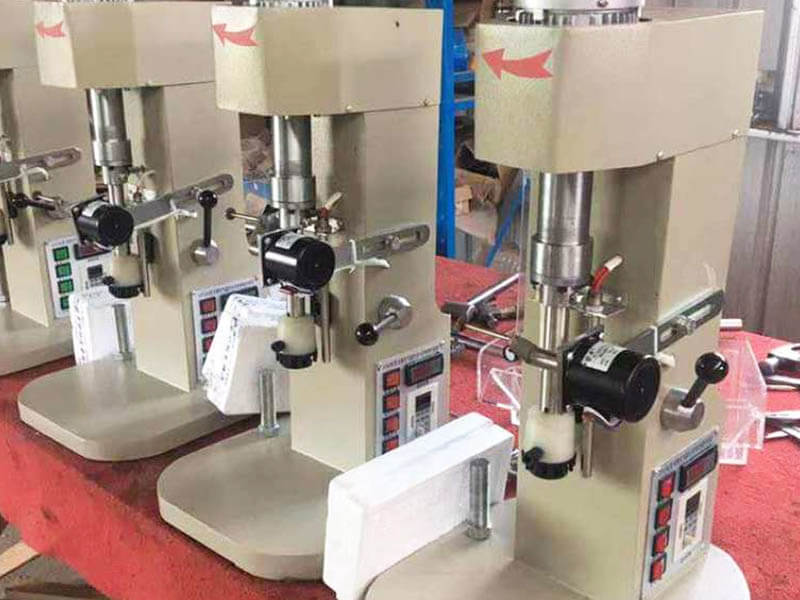In the beneficiation field, laboratory fluorspar (fluorite) ore flotation testing is a key component in assessing the feasibility of extracting valuable fluorspar from the ore. Laboratory flotation testing of fluorspar minerals is important in understanding this valuable mineral’s behavior and processing potential. By subjecting fluorite ore samples to various flotation conditions, researchers can determine the optimal combination of reagents and operating parameters for efficient recovery. Additionally, the test can evaluate different flotation techniques, such as bulk flotation or selective flotation, to achieve the desired fluorspar grade and recovery.
One of the key insights gained from laboratory flotation testing is the effect of impurities on the floatability of fluorspar. Understanding how impurities, such as calcium carbonate, silica, or other gangue minerals, affect flotation is critical to designing effective beneficiation strategies. Additionally, these tests can reveal the impact of factors such as pH, slurry density, and particle size on fluorspar recovery and grade, providing valuable information for optimizing industrial-scale operations.
Necessary Equipment for fluorite flotation testing
When conducting fluorspar flotation testing, having a range of necessary equipment and materials is important. First, having a high-quality microscope is critical to examining fluorite samples’ mineralogy and release characteristics. This provides a deeper understanding of the ore and helps optimize the flotation process. Among them, one of the most important equipment is a flotation machine (such as a mechanical or pneumatic cell), which performs batch testing of particles of different sizes. It is used to separate valuable minerals from gangue through the flotation process. Choosing a reputable and reliable machine that delivers consistent performance and repeatable results is important.
In addition, using reagents is the basis for fluorite flotation testing. Collectors such as fatty acids or mixed collectors help selectively float fluorite from other minerals, while inhibitors such as sodium silicate help control unwanted gangue minerals. PH adjusters and foaming agents are important in achieving the desired flotation and foam stability. This ensures optimal conditions for efficient mineral separation are maintained while providing essential insights for process optimization.

fluorite flotation testing steps
Fluorite flotation testing is a critical process in the mining industry to separate fluorspar from other non-valuable materials through flotation agents.
- Sample preparation includes crushing and grinding fluorite ore to the specified particle size. This ensures uniformity and consistency in the testing process.
- Mix the sample with water and flotation agents (such as collectors and frothers). The mixture is then stirred in a flotation cell to create a froth containing fluorspar particles. It involves conditioning the sample with various reagents to promote the selective attachment of desired minerals to bubbles. This critical stage requires careful consideration of pH, dosage, and reaction time to optimize flotation.
- Inject air bubbles into the adjusted slurry to selectively separate fluorite from other minerals based on its surface properties. The process relies on careful control of airflow, foam depth, and stirring speed to achieve optimal separation efficiency.
- After the foam forms, collect it and dry it for further analysis. The concentration of fluorspar in the foam can be determined by a variety of methods, such as chemical analysis or weighing the dried concentrate to assess its quality and grade.
FAQs in Flotation Testing
- There are impurities in the components of the ore, which will affect the efficiency of the flotation process. To address this issue, the ore composition must be thoroughly analyzed and understood before any testing can be performed. Researchers can identify and quantify impurities by employing advanced analytical techniques such as X-ray fluorescence (XRF) and scanning electron microscopy (SEM), allowing for more targeted and efficient testing.
- Several variables typically affect this flotation process, including pH, reagent type and dosage, pulp density, and particle size. By conducting thorough testing under various conditions, researchers can gain insights into how these factors interact and optimize the flotation process for maximum efficiency. A comprehensive mineralogical study is performed on multiple ore samples to determine trends in mineral composition and flotation patterns.
- It usually also involves the role of modifiers in the flotation of fluorite ore. Modifiers play a vital role by selectively changing the surface properties of minerals to enhance their palatability or inhibit undesirable gangue minerals. Understanding the mechanisms behind these modifiers, such as sodium silicate, water glass, or citric acid, is critical to obtaining high-grade fluorspar concentrates with minimal impurities.
By carefully studying how these minerals interact during flotation, researchers can gain valuable insights to design selective flotation strategies. Effectively separates fluorspar from other associated minerals. Laboratory flotation testing provides a unique opportunity to explore innovative methods and advance the sustainable mining of fluorspar minerals. With rigorous experiments, data analysis, and access to experienced professionals to address these issues, researchers and engineers can improve their understanding of fluorite ore flotation and develop more efficient testing processes and equipment.
